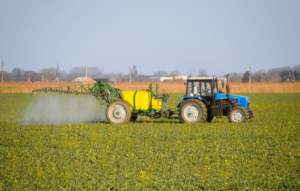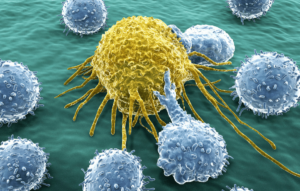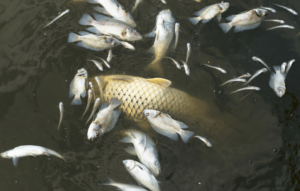Glyphosate is a name that might not be familiar to everyone, but its presence is made in nearly every corner of our environment. As the active ingredient in many popular herbicides, including Roundup, glyphosate has been widely used since the 1970s to kill weeds and unwanted plants. It has become a staple in modern agriculture, gardening, and even in public spaces like parks and schools. But as its use has skyrocketed, so too have concerns about its impact on human health and the environment.
In recent years, glyphosate has been at the center of heated debates, legal battles, and scientific scrutiny. While some view it as an essential tool for increasing agricultural productivity, others point to mounting evidence linking glyphosate to serious health risks, including cancer, hormonal disruption, and damage to vital organs. Meanwhile, its environmental footprint has raised alarms about its effects on soil health, water quality, and biodiversity.
This blog explores the hidden dangers of glyphosate — a chemical that most of us encounter daily without even realizing it. By becoming aware of the risks associated with its widespread use, we can make more informed choices and advocate for safer, more sustainable, and ultimately more responsible practices.
The Ubiquity of Glyphosate
Glyphosate’s extensive use means it is virtually everywhere — from the fields where our food is grown to the public parks where children play. Originally developed for large-scale agricultural operations, this herbicide has now become a household name, utilized not only by farmers but also by gardeners, landscapers, and municipal workers. It’s estimated that over 1.6 billion kilograms of glyphosate have been sprayed globally since its introduction, making it one of the most widely used weed killers in history.

However, the widespread application of glyphosate comes with a hidden cost: residues of this chemical are increasingly found in our food, water, and even the air. Studies have detected glyphosate in a range of common foods — from cereals and grains to fruits and vegetables. Even organic products, which should be free from synthetic chemicals, have occasionally been found to contain traces of glyphosate due to contamination from nearby fields or water sources.
The pervasive presence of glyphosate isn’t just limited to what we eat. It has also been found in drinking water, rivers, and streams, sometimes in concentrations higher than those deemed safe by regulatory agencies. Recent tests have detected glyphosate residues in most human urine samples across various populations, a clear indication that most of us are being exposed to this chemical on a regular basis. As glyphosate becomes more entrenched in our environment, the risks associated with its presence continue to grow, raising urgent questions about how much exposure is too much and what we can do to protect ourselves.
Health Concerns Associated with Glyphosate
The health risks linked to glyphosate exposure are a major source of controversy and concern. While regulatory agencies and manufacturers have often downplayed the dangers, a growing body of research suggests that glyphosate may pose significant threats to human health. Among the most alarming potential risks is its link to cancer. In 2015, the World Health Organization’s International Agency for Research on Cancer (IARC) classified glyphosate as a “probable human carcinogen,” pointing to studies that associate its use with non-Hodgkin lymphoma and other cancers. Subsequent lawsuits involving individuals exposed to glyphosate have led to multi-million dollar verdicts, reflecting public and judicial acknowledgment of these concerns.
Beyond cancer, glyphosate has also been implicated in other serious health issues, particularly concerning its impact on the endocrine system. As an endocrine disruptor, glyphosate interferes with hormone functions, potentially leading to reproductive problems, birth defects, and developmental delays. Studies suggest that even low levels of glyphosate exposure can affect hormone production and signaling, with far-reaching consequences for fertility and overall health.
Other health impacts attributed to glyphosate exposure include damage to vital organs like the liver and kidneys. Research has shown that chronic exposure, even at low levels, may cause liver enzyme disturbances and kidney toxicity. Additionally, glyphosate has been linked to disruptions in the gut microbiome — the complex ecosystem of bacteria that plays a crucial role in digestion, immunity, and overall well-being. Animal studies have indicated that glyphosate may reduce beneficial bacteria in the gut, potentially contributing to a range of health issues, from digestive disorders to immune dysfunction.
As evidence continues to emerge, it is clear that the health risks associated with glyphosate are complex and multifaceted. While definitive answers may still be the subject of ongoing scientific debate, the potential dangers warrant serious consideration, especially given how prevalent this chemical is in our daily lives.
Glyphosate’s Impact on the Environment
Glyphosate’s effects extend far beyond human health; it’s a significant threat to the environment as well. As one of the most widely used herbicides globally, glyphosate’s impact on ecosystems is profound and far-reaching. One of its most concerning effects is its ability to harm non-target plant species, leading to a decline in biodiversity. By killing weeds and other plants indiscriminately, glyphosate disrupts local habitats and diminishes the variety of plants available, which can have cascading effects on the entire food web. When plants that provide food or shelter for insects, birds, and other wildlife disappear, the delicate balance of the ecosystem is thrown off, threatening the survival of many species.
The impact on pollinators, such as bees, is especially alarming. Bees play a crucial role in pollinating many of the crops that make up our food supply, yet glyphosate exposure has been shown to harm their health and behavior. Studies have found that glyphosate can affect bees’ gut microbiota, weakening their immune systems and making them more susceptible to pathogens and environmental stressors. Additionally, glyphosate residues in wildflowers and other plants can reduce bees’ ability to forage and navigate, contributing to the decline of bee populations worldwide.
Glyphosate also poses a threat to aquatic life. When it washes off fields and gardens, it can contaminate nearby water sources, harming fish, amphibians, and other aquatic organisms. Some research indicates that even low levels of glyphosate in water can disrupt the growth and reproduction of aquatic species, impacting entire ecosystems.

Another critical issue is the emergence of glyphosate-resistant weeds, often called “superweeds.” These weeds have adapted to survive glyphosate applications, leading to increased herbicide use and a vicious cycle of resistance and chemical escalation. Farmers, facing fields overrun by resistant weeds, may resort to using even more potent and toxic chemicals, further intensifying environmental damage.
The widespread and indiscriminate use of glyphosate has created a complex web of environmental challenges. Its impact on plant life, pollinators, aquatic species, and the emergence of resistant superweeds raises significant concerns about its sustainability. As we continue to assess glyphosate’s place in agriculture and public spaces, it is crucial to consider these broader environmental implications and seek more responsible and sustainable solutions.
Legal Battles and Scientific Disputes
Glyphosate is not just a subject of scientific study; it is also at the center of intense legal battles and heated public debate. One of the most high-profile cases involves lawsuits against Bayer, the parent company of Monsanto, the original developer of glyphosate-based herbicides like Roundup. Over the past few years, thousands of individuals have sued the company, alleging that their exposure to glyphosate caused cancer, specifically non-Hodgkin lymphoma. Some of these cases have resulted in substantial settlements, with juries awarding plaintiffs hundreds of millions of dollars in damages, signaling a significant acknowledgment of the potential risks associated with glyphosate use.
However, the legal outcomes are just one part of the broader controversy. The scientific community remains divided over glyphosate’s safety. While some studies, such as those cited by the World Health Organization’s International Agency for Research on Cancer (IARC), have raised red flags about glyphosate being a probable human carcinogen, other studies funded by industry stakeholders suggest it is safe when used as directed. This split has led to a polarized debate, with different regulatory bodies around the world adopting contrasting stances on its safety. For instance, the European Union has seen heated discussions, with some member states advocating for a total ban while others, like Germany, push for more gradual phase-outs.
Adding to the confusion is the fact that regulatory agencies in different countries have taken totally contradicting approaches to managing glyphosate. While countries like France and Austria have moved towards banning or significantly restricting its use, the United States Environmental Protection Agency (EPA) has maintained that glyphosate is unlikely to cause cancer in humans if used properly. This discrepancy often stems from differing interpretations of scientific data, the influence of industry lobbying, and varying public health priorities.
The ongoing controversy around glyphosate highlights a critical challenge in balancing agricultural needs with health and environmental safety. As more studies are conducted and legal battles unfold, the future of glyphosate remains uncertain. What is clear, however, is the growing call for more independent research, transparency, and caution in the use of this pervasive chemical, as we navigate the complex terrain of its risk
Steps to Reduce Your Exposure to Glyphosate
Given the widespread use of glyphosate and its potential health risks, minimizing exposure to this chemical is essential in protecting yourself and your loved ones.
- Choose Organic Foods When Possible: Organic farming prohibits the use of synthetic herbicides like glyphosate, making organic foods a safer choice. While organic products can sometimes contain trace amounts of glyphosate due to cross-contamination from nearby conventional fields, the levels are generally much lower. Prioritize buying organic versions of foods that are most likely to be contaminated, such as oats, wheat, lentils, and beans.
- Wash Fruits and Vegetables Thoroughly: While washing produce won’t eliminate all pesticide residues, it can help reduce some of the glyphosate present on the surface. Use a vegetable brush for scrubbing and consider soaking fruits and vegetables in a vinegar-water solution to remove additional residues.
- Avoid Using Glyphosate-Based Products in Your Garden: Many people unknowingly contribute to glyphosate exposure by using weed killers like Roundup in their own yards and gardens. Opt for natural weed control methods, such as mulching, hand weeding, or using vinegar-based solutions. These alternatives are safer for both you and the environment.
- Advocate for Glyphosate-Free Public Spaces: Join or support local movements that advocate for glyphosate-free public parks, schools, and other communal areas. Many communities have already banned or limited glyphosate use in public spaces due to health and environmental concerns, and public pressure can help expand these initiatives.
- Support Sustainable and Regenerative Agriculture: By choosing to buy from local farmers who use sustainable, regenerative practices, you can help reduce the overall demand for glyphosate-based herbicides. Regenerative agriculture emphasizes soil health, biodiversity, and natural pest management techniques, reducing the need for chemical inputs.
- Push for Better Regulation and Transparency: Advocacy at a broader level is also essential to ensure more stringent regulations on glyphosate use – we all have to speak up. Support organizations working to raise awareness about pesticide risks and call for better labeling practices to inform consumers about potential chemical residues in their food.

By taking these steps, you can significantly reduce your exposure to glyphosate and contribute to a broader movement towards healthier, more sustainable agricultural practices. Every choice you make — from the foods you buy to the products you use and the advocacy you engage in — can make a difference in protecting your health and the environment.
Closing Thoughts
Glyphosate may be an effective weed killer, but its potential risks to human health and the environment cannot be ignored. From its pervasive presence in our food and water to its harmful effects on ecosystems and biodiversity, the concerns surrounding glyphosate are real and growing. While the debate over its safety continues, we can take practical steps to reduce our exposure and support more sustainable practices.
By staying informed, making conscious choices, and advocating for stronger regulations, we can help protect ourselves and our planet from the hidden dangers of glyphosate. Now is the time for greater awareness and action — for our health, our communities, and the environment we all share.








